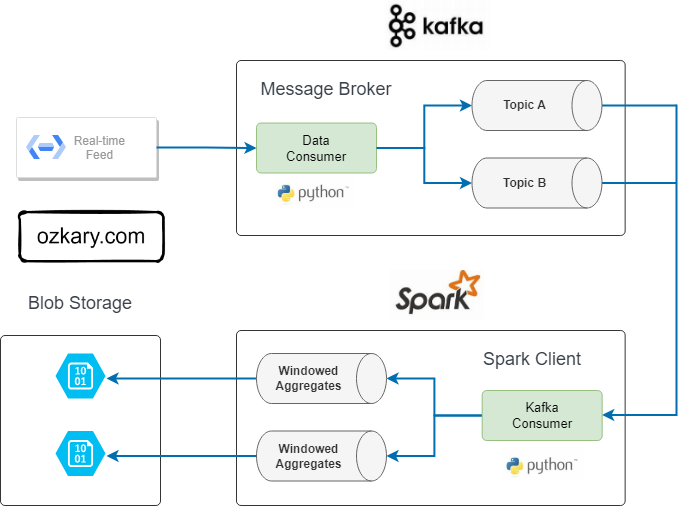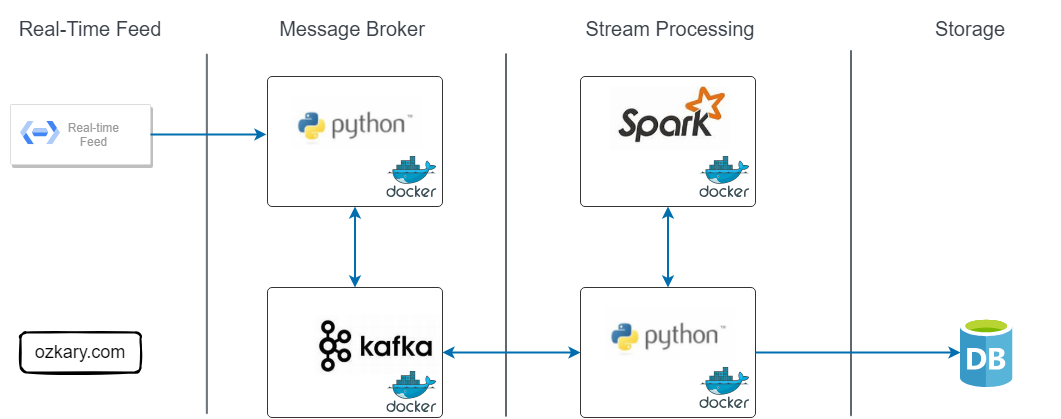In modern data engineering solutions, handling streaming data is very important. Businesses often need real-time insights to promptly monitor and respond to operational changes and performance trends. A data streaming pipeline facilitates the integration of real-time data into data warehouses and visualization dashboards. To achieve this integration in a data engineering solution, understanding the principles of data streaming is essential, and how technologies like Apache Kafka and Apache Spark play a key role in building efficient streaming data pipelines.
👉 Data Engineering Process Fundamentals - Data Analysis and Visualization
What is Data Streaming
Data streaming enables us to build data integration in real-time. Unlike traditional batch processing, where data is collected and processed periodically, streaming data arrives continuously by and is processed on-the-fly. This kind of integration empowers organizations to:
- React Instantly: Timely responses to events and anomalies become possible
- Predict Trends: Identify patterns and trends as they emerge
- Enhance User Experience: Provide real-time updates and personalization
- Optimize Operations: Streamline processes and resource allocation

Data Streaming Channels
Data streaming is a continuous data flow which can arrive from a channel that is usually hosted on an HTTP end-point. The type of the channel technology depends on the provider technology stack and can be any of the following:
Web Hooks: Web hooks are like virtual messengers that notify us when something interesting happens on the web. They are HTTP callbacks triggered by specific events, such as a change in a system. To harness data from web hooks, we set up endpoints that listen for these notifications, allowing us to react instantly to changes.
Events: Events are a fundamental concept in data streaming. They represent occurrences in a system or application, such as a user click, a sensor detecting a temperature change, or a train arrival to a station. Events can be collected and processed in real-time by using a middleware platform like Apache Kafka or RabbitMQ, providing insights into user behavior, system health, and more.
API Integration: APIs (Application Programming Interfaces) are bridges between different software systems. Through API integration, we can fetch data from external services, social media platforms, IoT devices, or any source that exposes an API. This seamless connectivity enables us to incorporate external data into our applications and processes by scheduling calls to the API at a certain frequency.
👍 Events are used for a wide range of real-time applications, including IoT data collection, application monitoring, and user behavior tracking. Web hooks are typically employed for integrating external services, automating workflows, and receiving notifications from third-party platforms.
Scaling to Handle a Data Stream
Data streaming sources often produce small payload size with high volume of messages. This introduces scalability concerns that should be addressed with essential components like the following:
Streaming Infrastructure: Robust streaming infrastructure is the backbone of data streaming. This includes systems like Apache Kafka, AWS Kinesis, or Azure Stream Analytics, which facilitate the ingestion, processing, and routing of data streams
Real-Time Processing: Traditional batch processing won't cut it for data streaming. We need real-time processing frameworks like Apache Storm, or Apache Spark Streaming to handle data as it flows
Data Storage: Storing and managing streaming data is crucial. we might use data lakes for long-term storage and databases optimized for real-time access. Cloud storage solutions offer scalability and reliability
Analytics and Visualization: To derive meaningful insights, we need analytics tools capable of processing streaming data. Visualization platforms like PowerBI, Looker, or custom dashboards can help you make sense of the information in real time
Monitoring and Alerts: Proactive monitoring ensures that your data streaming pipeline is healthy. Implement alerts and triggers to respond swiftly to anomalies or critical events
Scalable Compute Resources: As data volumes grow, compute resources should be able to scale horizontally to handle increased data loads. Cloud-based solutions are often used for this purpose
Data Streaming Components
At the heart of data streaming solutions lies technologies like Apache Kafka, a distributed event streaming platform, and Apache Spark, a versatile data processing engine. Together, they form a powerful solution that ingests, processes, and analyzes streaming data at scale.

Apache Kafka
Kafka acts as the ingestion layer or message broker in the streaming pipeline. It serves as a highly durable, fault-tolerant, and scalable event streaming platform. Data producers, which can be various sources like applications, sensors, or webhooks publish events (messages) to Kafka topics. These events are typically small pieces of data containing information such as transactions, logs, or sensor readings. Let's look at a simplified overview of how Kafka works:
Kafka organizes events into topics. A topic is a logical channel or category to which records (messages) are sent by producers and from which records are consumed by consumers. Topics serve as the central mechanism for organizing and categorizing data within Kafka. Each topic can have multiple partitions to support fail-over scenarios
- Kafka is distributed and provides fault tolerance. If a broker (Kafka server) fails, partitions can be replicated across multiple brokers
Kafka follows a publish-subscribe model. Producers send records to topics, and consumers subscribe to one or more topics to receive and process those records
A producer is a program or process responsible for publishing records to Kafka topics. Producers generate data, which is then sent to one or more topics. Each message in a topic is identified by an offset, which represents its position within the topic.
A consumer is a program or process that subscribes to one or more topics and processes the records within them. Consumers can read data from topics in real-time and perform various operations on it, such as analytics, storage, or forwarding to other systems
Apache Spark Structured Streaming
Apache Spark Structured Streaming is a micro-batch processing framework built on top of Apache Spark. It enables real-time data processing by ingesting data from Kafka topics in mini-batches. Here's how the process works:
👍 Apache Spark offers a unified platform for both batch and stream processing. If your application requires seamless transitions between batch and stream processing modes, Spark can be a good fit.
Kafka Integration: Spark Streaming integrates with Kafka using the Kafka Direct API. It can consume data directly from Kafka topics, leveraging Kafka's parallelism and fault tolerance features
Mini-Batch Processing: Spark Streaming reads data from Kafka topics in mini-batches, typically ranging from milliseconds to seconds. Each mini-batch of data is treated as a Resilient Distributed Dataset (RDD) within the Spark ecosystem
Data Transformation: Once the data is ingested into Spark Streaming, we can apply various transformations, computations, and analytics on the mini-batches of data. Spark provides a rich set of APIs for tasks like filtering, aggregating, joining, and machine learning
Windowed Operations: Spark Streaming allows us to perform windowed operations, such as sliding windows or tumbling windows, to analyze data within specific time intervals. This is useful for aggregating data over fixed time periods (e.g., hourly, daily) or for tracking patterns over sliding windows
Output: After processing, the results can be stored in various destinations, such as a data lake (e.g., Hadoop HDFS), a data warehouse (e.g., BigQuery, Redshift), or other external systems. Spark provides connectors to these storage solutions for seamless data persistence
Benefits of a Kafka and Spark Integration
A Kafka and Spark integration enables us to build solutions with High Availability requirements due to the following features:
Fault Tolerance: Kafka ensures that events are not lost even in the face of hardware failures, making it a reliable source of data
Scalability: Kafka scales horizontally, allowing you to handle increasing data volumes by adding more Kafka brokers
Flexibility: Spark Streaming's flexibility in data processing and windowing operations enables a wide range of real-time analytics
End-to-End Pipeline: By combining Kafka's ingestion capabilities with Spark's processing power, you can create end-to-end data streaming pipelines that handle real-time data ingestion, processing, and storage
Supported Programming Languages
When it comes to programming language support, both Kafka and Spark allows developers to choose the language that aligns best with their skills and project requirements.
Kafka supports multiple programming languages, including Python, C#, and Java
Spark also support multiple programming languages like PySpark (Python), Scala, and even R for data processing tasks. Additionally, Spark allows users to work with SQL-like expressions, making it easier to perform complex data transformations and analysis
Sample Python Code for a Kafka Producer
This is a very simple implementation of a Kafka producer using Python as the programming language. This code does not consume a data feed from a provider. It only shows how a producer sends messages to a Kafka topic.
from kafka import KafkaProducer
import time
kafka_broker = "localhost:9092"
# Create a Kafka producer instance
producer = KafkaProducer(
bootstrap_servers=kafka_broker, # Replace with your Kafka broker's address
value_serializer=lambda v: str(v).encode('utf-8')
)
# Sample data message (comma-delimited)
sample_message = "timestamp,station,turnstile_id,device_id,entry,exit,entry_datetime"
try:
# continue to run until the instance is shutdown
while True:
# Simulate generating a new data message. This data should come from the data provider
data_message = sample_message + f"\n{int(time.time())},StationA,123,456,10,15,'2023-07-12 08:30:00'"
# Send the message to the Kafka topic
producer.send('turnstile-stream', value=data_message)
# add logging information for tracking
print("Message sent:", data_message)
time.sleep(1) # Sending messages every second
except KeyboardInterrupt:
pass
finally:
producer.close()
This Kafka producer code initializes a producer and sends a sample message to the specified Kafka topic. Let's review each code segment:
Create Kafka Producer Configuration:
- Set up the Kafka producer configuration
- Specify the Kafka broker(s) to connect to
(bootstrap.servers)
Define Kafka Topic: Define the Kafka topic to send messages (turnstile-stream in this example)
Create a Kafka Producer:
- Create an instance of the Kafka producer with the broker end-point
- Use a
value_serializerto encode the string message with unicode utf-8
Define Message Contents:
- Prepare the message to send as a CSV string with the header and value information
Produce Messages:
- Use the send method of the Kafka producer to send messages to the Kafka topic, turnstile-stream
Close the Kafka Producer:
- Always remember to close the Kafka producer when the application terminates to avoid leaving open connections on the broker
Sample Python Code for a Kafka Consumer and Spark Client
After looking at the Kafka producer code, let's take a look at how a Kafka consumer on Spark would consume and process the messages.
from pyspark.sql import SparkSession
from pyspark.streaming import StreamingContext
from pyspark.streaming.kafka import KafkaUtils
from pyspark.sql.functions import window, sum
# Create a Spark session
spark = SparkSession.builder.appName("TurnstileStreamApp").getOrCreate()
# Create a StreamingContext with a batch interval of 5 seconds
ssc = StreamingContext(spark.sparkContext, 5)
kafka_broker = "localhost:9092"
# Define the Kafka broker and topic to consume from
kafkaParams = {
"bootstrap.servers": kafka_broker, # Replace with your Kafka broker's address
"auto.offset.reset": "latest",
}
topics = ["turnstile-stream"]
# Create a Kafka stream
kafkaStream = KafkaUtils.createDirectStream(ssc, topics, kafkaParams)
# Parse the Kafka stream as a DataFrame
lines = kafkaStream.map(lambda x: x[1])
df = spark.read.csv(lines)
# Define a window for aggregation (4-hour window)
windowed_df = df
.withWatermark("entry_datetime", "4 hours") \
# 4-hour window with a 4-hour sliding interval
.groupBy("station", window("entry_datetime", "4 hours"))
.agg(
sum("entries").alias("entries"),
sum("exits").alias("exits")
)
# Write the aggregated data to a blob storage as compressed CSV files
query = windowed_df.writeStream\
.outputMode("update")\
.foreachBatch(lambda batch_df, batch_id: batch_df.write\
.mode("overwrite")\
.csv("gs://your-bucket-name/") # Replace with your blob storage path
)\
.start()
query.awaitTermination()
This simple example shows how to write a Kafka consumer, use Spark to process and aggregate the data, and finally write a csv file to the data lake. Let’s look at each code segment for more details:
Create a Spark Session:
- Initialize a Spark session with the name "TurnstileStreamApp"
Create a StreamingContext:
- Set up a StreamingContext with a batch interval of 5 seconds. This determines how often Spark will process incoming data
Define Kafka Broker and Topic:
- Specify the Kafka broker's address (localhost:9092 in this example) and the topic to consume data from ("turnstile-stream")
Create a Kafka Stream:
- Use KafkaUtils to create a direct stream from Kafka
- The stream will consume data from the specified Kafka topic
Parse the Kafka Stream:
- Extract the message values from the Kafka stream
- Read these messages into a DataFrame (
df) using Spark's CSV reader
Define a Window for Aggregation:
- We specify the watermark for late data using
withWatermark. This ensures that any data arriving later than the specified window is still considered for aggregation - Create a windowed DataFrame (
windowed_df) by grouping data based on "station" and a 4-hour window - The "entry_datetime" column is used as the timestamp for windowing
- Aggregations are performed to calculate the sum of "entries" and "exits" within each window
- We specify the watermark for late data using
Write the Aggregated Data to a Data Lake:
- Define a streaming query (
query) to write the aggregated data to a blob storage path - The "update" output mode indicates that only updated results will be written
- A function is applied to each batch of data, which specifies how to write the data
- In this case, data is written as compressed CSV files to a data lake location
- The
awaitTerminationmethod ensures the query continues to run and process data until manually terminated.
- Define a streaming query (
This Spark example processes data from Kafka, aggregates it in 4-hour windows, and it writes the results to blob storage. The code is structured to efficiently handle real-time streaming data and organize the output into folders in the data lake based on station names and time windows. In each folder, Spark will generate filenames automatically based on the default naming convention. Typically, it uses a combination of a unique identifier and partition number to create filenames. The exact format of the file name might vary depending on the Spark version and configuration. This approach is used to send the information to a data lake, so the data transformation process can pick it up and send to a data warehouse.
Alternatively, the Spark client can send the aggregated results directly in the data warehouse. The Spark client can connect to the data warehouse, so it can directly insert the information without using a data lake as an staging step.
Solution Design and Architecture
For our solution strategy, we followed the design shown below. This design helps us ensure smooth flow, efficient processing and storage of data so that it is immediately available in our data warehouse consequently, the visualization tools. Let's break down each component and explain its purpose.

Components
Real-Time Data Source: This is an external data source, which continuously emits data as events or messages
Message Broker Layer: Our message broker layer is the central hub for data ingestion and distribution. It consists of two vital components:
- Kafka Broker Instance: Kafka acts as a scalable message broker and entry point for data ingestion. It efficiently collects and organizes data in topics from the source
- Kafka Producer (Python): To bridge the gap between the data source and Kafka, we write a Python-based Kafka producer. This component is responsible for capturing data from the real-time source and forwarding it to the Kafka instance and corresponding topic
Stream Processing Layer: The stream processing layer is where the messages from Kafka are processed, aggregated and sent to the corresponding data storage. This layer also consists of two key components:
- Spark Instance: Apache Spark, a high-performance stream processing framework, is responsible for processing and transforming data in real-time
- Stream Consumer (Python): In order to consume the messages from a Kafka topic, we write a Python component that acts as both a Kafka Consumer and Spark application.
- The Kafka consumer retrieves data from the Kafka topic, ensuring that the data is processed as soon as it arrives
- The Spark application process the messages, aggregates the data and saves the results in the data warehouse. This dual role ensures efficient data processing and storage.
Data Warehouse: As the final destination for our processed data, the data warehouse provides a reliable and structured repository for storing the results of our real-time data processing, so visualization tools like Looker and PowerBI can display the data as soon as the dashboards are refreshed
👉 We should note that dashboards query the data from the database. For a near real-time data to be available, the dashboard data needs to be refreshed at certain intervals (e.g., minutes or hourly). To make available the real-time data to the dashboard, there needs to be a live connection (socket) between the dashboard and the streaming platform, which is done by another system component, like Redis Cache or custom service, that could push those events on a socket channel.
DevOps Support
Containerization: In order to continue to meet our DevOps requirements, enhance scalability and manageability, and follow best enterprise level practices, we use Docker containers for all of our components. Each component, our Kafka and Spark instance as well as our two Python-based components, runs in separate Docker container. This ensures modularity, easy deployment, and resource isolation
- This approach also enable us to use a Kubernetes cluster , a container orchestration platform that can help us manage and deploy Docker containers at scale, to run our components. We could use Minikube for local development or use a cloud-managed Kubernetes service like Google Kubernetes Engine (GKE), Amazon Elastic Kubernetes Service (EKS), or Azure Kubernetes Service (AKS)
Virtual Machine (VM): Our components need to run on a VM, so we follow the same approach and create a VM instance using a Terraform script, similar to how it was done for our batch data pipeline during our planning and design phase
Advantages
Our data streaming design offers several advantages:
- Real-time Processing: Data is processed as it arrives, enabling timely insights and rapid response to changing conditions
- Scalability: The use of Kafka and Spark allows us to scale our architecture effortlessly to handle growing data volumes
- Containerization: Docker containers simplify deployment and management, making our system highly portable and maintainable
- Integration: The seamless integration of Kafka, Spark, and the Kafka consumer as a Spark client ensures data continuity and efficient processing
This data streaming strategy, powered by Kafka and Spark, empowers us to unlock real-time insights from our data streams, providing valuable information for rapid decision-making, analytics, and storage.
Summary
In today's data-driven landscape, data streaming solutions are an absolute necessity, enabling the rapid processing and analysis of vast amounts of real-time data. Technologies like Kafka and Spark play a pivotal role in empowering organizations to harness real-time insights from their data streams.
Kafka and Spark, work together seamlessly to enable real-time data processing and analytics. Kafka handles the reliable ingestion of events, while Spark Streaming provides the tools for processing, transforming, analyzing, and storing the data in a data lake or data warehouse in near real-time, allowing businesses to make decisions much at a much faster pace.
Exercise - Data Streaming with Apache Kafka
Now that we have defined the data streaming strategy, we can continue our journey and build a containerized Kafka producer that can consume real-time data sources. Let's take a look at that next.
👉 Data Engineering Process Fundamentals - Data Streaming With Apache Kafka and Spark Exercise
Thanks for reading.
Send question or comment at Twitter @ozkary
👍 Originally published by ozkary.com








0 comments :
Post a Comment
What do you think?